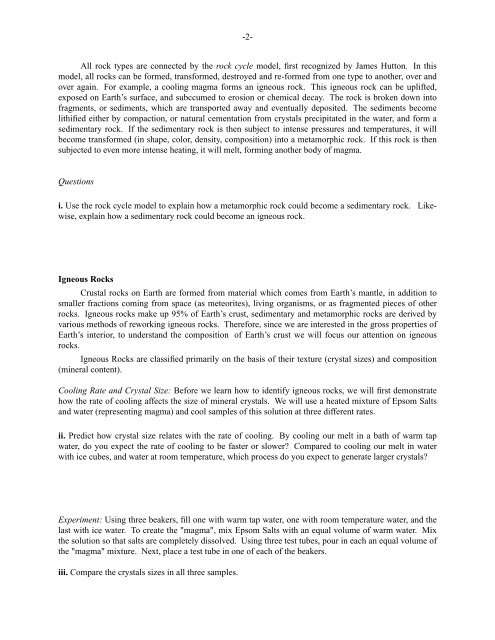Lab 4: Rock-cycle and Igneous Rocks Earth 202: Earth's Interior
Lab 4: Rock-cycle and Igneous Rocks Earth 202: Earth's Interior
Lab 4: Rock-cycle and Igneous Rocks Earth 202: Earth's Interior
Create successful ePaper yourself
Turn your PDF publications into a flip-book with our unique Google optimized e-Paper software.
-2-<br />
All rock types are connected by the rock <strong>cycle</strong> model, first recognized by James Hutton. In this<br />
model, all rocks can be formed, transformed, destroyed <strong>and</strong> re-formed from one type to another, over <strong>and</strong><br />
over again. For example, a cooling magma forms an igneous rock. This igneous rock can be uplifted,<br />
exposed on <strong>Earth</strong>’s surface, <strong>and</strong> subccumed to erosion or chemical decay. The rock is broken down into<br />
fragments, or sediments, which are transported away <strong>and</strong> eventually deposited. The sediments become<br />
lithified either by compaction, or natural cementation from crystals precipitated in the water, <strong>and</strong> form a<br />
sedimentary rock. If the sedimentary rock is then subject to intense pressures <strong>and</strong> temperatures, it will<br />
become transformed (in shape, color, density, composition) into a metamorphic rock. If this rock is then<br />
subjected to even more intense heating, it will melt, forming another body of magma.<br />
Questions<br />
i. Use the rock <strong>cycle</strong> model to explain how ametamorphic rock could become a sedimentary rock. Likewise,<br />
explain how asedimentary rock could become an igneous rock.<br />
<strong>Igneous</strong> <strong>Rock</strong>s<br />
Crustal rocks on <strong>Earth</strong> are formed from material which comes from <strong>Earth</strong>’s mantle, in addition to<br />
smaller fractions coming from space (as meteorites), living organisms, or as fragmented pieces of other<br />
rocks. <strong>Igneous</strong> rocks make up95% of <strong>Earth</strong>’s crust, sedimentary <strong>and</strong> metamorphic rocks are derived by<br />
various methods of reworking igneous rocks. Therefore, since we are interested in the gross properties of<br />
<strong>Earth</strong>’s interior, tounderst<strong>and</strong> the composition of <strong>Earth</strong>’s crust we will focus our attention on igneous<br />
rocks.<br />
<strong>Igneous</strong> <strong>Rock</strong>s are classified primarily on the basis of their texture (crystal sizes) <strong>and</strong> composition<br />
(mineral content).<br />
Cooling Rate <strong>and</strong> Crystal Size: Before we learn how toidentify igneous rocks, we will first demonstrate<br />
how the rate of cooling affects the size of mineral crystals. We will use a heated mixture of Epsom Salts<br />
<strong>and</strong> water (representing magma) <strong>and</strong> cool samples of this solution at three different rates.<br />
ii. Predict how crystal size relates with the rate of cooling. By cooling our melt in a bath of warm tap<br />
water, doyou expect the rate of cooling to be faster or slower? Compared to cooling our melt in water<br />
with ice cubes, <strong>and</strong> water at room temperature, which process do you expect to generate larger crystals?<br />
Experiment: Using three beakers, fill one with warm tap water, one with room temperature water, <strong>and</strong> the<br />
last with ice water. Tocreate the "magma", mix Epsom Salts with an equal volume of warm water. Mix<br />
the solution so that salts are completely dissolved. Using three test tubes, pour in each an equal volume of<br />
the "magma" mixture. Next, place a test tube in one of each of the beakers.<br />
iii. Compare the crystals sizes in all three samples.













